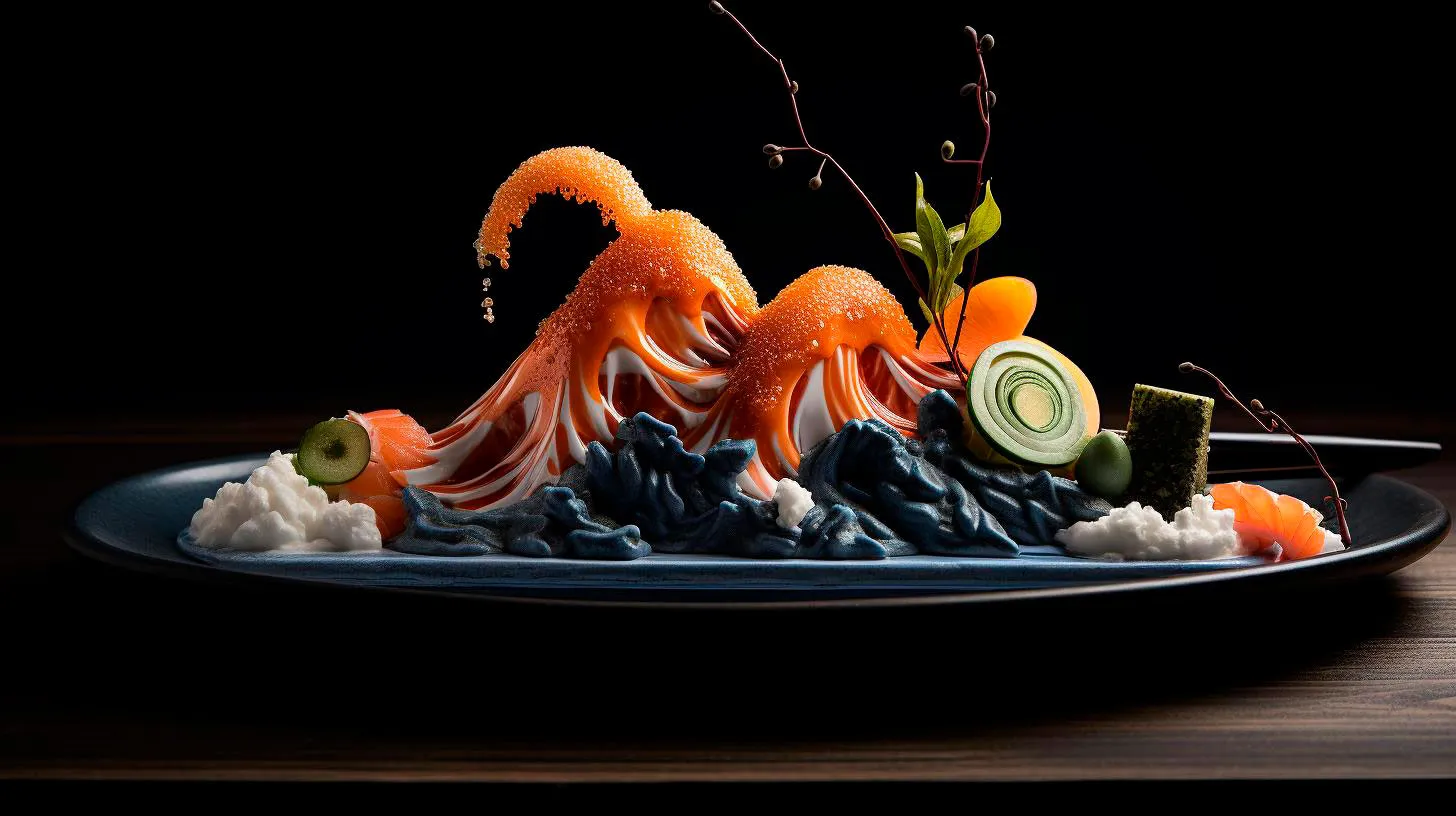The Rise of Sushi Robots: Automating Japan’s Fast Food Industry
The latest addition to this lineup is the rise of sushi robots, which are revolutionizing the way sushi is prepared and served. In this article, we will explore the growing trend of sushi robots and how they are transforming Japan’s fast food industry.
The Sushi Robot Phenomenon
Sushi robots are machines designed to automate the sushi-making process. They are equipped with advanced technology and finely tuned precision to replicate the skill and expertise of sushi chefs. These robots can effortlessly produce large quantities of sushi at a faster pace than human chefs, leading to increased efficiency and productivity in sushi restaurants.
Key takeaways:
- Sushi robots automate the sushi-making process and replicate the expertise of sushi chefs.
- They enable faster production of large quantities of sushi, enhancing efficiency in restaurants.
- Sushi robots are equipped with advanced technology and precision to maintain consistent quality.
Advancements in robotics and artificial intelligence have significantly contributed to the development of sushi robots. These machines are meticulously programmed to prepare various types of sushi, including nigiri, maki, and temaki, with utmost precision. They can handle tasks such as rice cooking, rice rolling, fish slicing, and even assembling the final sushi pieces.
One major advantage of sushi robots is their ability to maintain consistent quality. Unlike human chefs who may have variations in their technique, sushi robots ensure the same level of precision and taste in each sushi piece produced. This consistency is vital in winning the trust of customers and enhancing the overall dining experience.
The rise of sushi robots is also driven by the demand for efficiency and cost-effectiveness in the fast food industry. By automating the sushi-making process, restaurant owners can reduce labor costs and streamline their operations. Sushi robots eliminate the need for extensive training and can work round the clock, leading to increased output and profitability for businesses.
Key advantages of sushi robots:
- Consistent quality: Sushi robots maintain uniform precision and taste in every sushi piece.
- Efficiency and productivity: They enable faster production and reduce labor costs.
- 24/7 operation: Sushi robots can work continuously, increasing output and profitability.
The Impact on Japan’s Fast Food Industry
The adoption of sushi robots has had a profound impact on Japan’s fast food industry. According to industry statistics, the market for sushi robots has been steadily growing, with an estimated annual growth rate of 12%. This growth is driven by both domestic demand and the increasing popularity of sushi worldwide.
The introduction of sushi robots has allowed fast food chains and sushi restaurants to expand their operations. By automating the sushi-making process, these establishments can cater to a larger customer base and serve sushi throughout the day without compromising quality. Sushi robots have also enabled businesses to open new branches, as the machines make it easier to replicate the same quality and consistency across multiple locations.
Key industry statistics:
- Annual growth rate of sushi robot market: 12%.
- Increased customer base and extended operating hours.
- Facilitates expansion and opening of new branches.
The introduction of sushi robots has not only improved efficiency and profitability but has also created new job opportunities. While it may seem contradictory to the idea of automation, the demand for sushi robots has led to the emergence of robot technicians and operators who are trained to maintain and operate these machines. As a result, the fast food industry has experienced a shift in job requirements, with a focus on technical skills and robotics expertise.
In conclusion, the rise of sushi robots is transforming Japan’s fast food industry by automating the sushi-making process. These machines bring consistency, efficiency, and cost-effectiveness to sushi restaurants and fast-food chains. While they may never fully replace the artistry of skilled sushi chefs, sushi robots have proven to be a valuable addition to the industry, meeting the growing demand for sushi worldwide. As technology continues to advance, we can expect further innovation in the automation of food preparation processes in the years to come.
From Conveyor Belts to Drones: Futuristic Delivery Methods at Japanese Sushi Restaurants
In this article, we will explore the evolution of these delivery methods and delve into the advantages and key takeaways they offer.
The Rise of Conveyor Belt Systems
Conveyor belt systems are undoubtedly the pioneers of futuristic delivery methods in Japanese sushi restaurants. Introduced in the 1950s, these systems revolutionized the way sushi was served and made it more accessible to customers. Consisting of a moving belt that carries small plates of sushi, customers can simply pick and choose the dishes they desire as they pass by their table.
Key Features and Advantages:
- Efficiency: Conveyor belt systems eliminate the need for waitstaff to take orders and deliver dishes.
- Speed: Customers can quickly select their preferred sushi options without waiting.
- Transparency: The open display of various sushi plates allows customers to see the available options instantly.
- Interactive Experience: Customers can actively participate in their dining experience by grabbing what they want.
- Variety: The continuous rotation of plates offers a wide range of sushi options, catering to diverse preferences.
According to a survey conducted by the Japan External Trade Organization, there are more than 3,000 restaurants in Japan that utilize conveyor belt systems, contributing significantly to the country’s sushi culture.
The Advent of Drone Deliveries
As technology continues to advance, Japanese sushi restaurants have taken a leap into the future with the introduction of drone deliveries. By implementing this innovative delivery method, sushi restaurants have created a buzz and captivated customers’ attention across the globe.
Drone deliveries involve specially designed unmanned aerial vehicles that transport sushi directly to the customer’s table. These drones are equipped with precise navigation systems, ensuring safe and efficient delivery.
Key Features and Advantages:
- Wow Factor: Drone deliveries offer a unique and captivating experience that leaves a lasting impression on customers.
- Efficiency and Speed: Drones bypass any potential obstacles, ensuring quick and seamless delivery.
- Safe Handling: With advanced collision avoidance technology, drones prioritize safety during the entire delivery process.
- Branding Opportunities: Restaurants can leverage drone deliveries to create a distinguishable brand image.
A report by the Global Market Insights estimates that the drone delivery market is expected to exceed $11 billion by 2026, emphasizing the potential impact and growth of this futuristic delivery method.
Key Takeaways
Japanese sushi restaurants have continuously pushed the boundaries by adopting futuristic delivery methods, enhancing the overall dining experience. The introduction of conveyor belt systems revolutionized the way sushi was served, offering efficiency, speed, and variety to customers. On the other hand, drone deliveries have added a touch of awe and excitement, providing safe and efficient transport of sushi directly to the tables.
While these delivery methods bring innovation and excitement, it is crucial for restaurants to strike a balance, ensuring they do not overshadow the essence of traditional sushi dining. Implementing these futuristic delivery methods should complement the restaurant’s ambiance and retain the cherished elements of Japanese culture.
As technology continues to evolve, we eagerly await to see what groundbreaking advancements Japanese sushi restaurants will introduce next. Whether it’s through conveyor belt systems, drone deliveries, or yet-to-be-conceived methods, one thing is certain – the future of sushi dining will be an experience like no other.
Sustainable Sushi: Eco-Friendly Initiatives Revolutionizing the Fast Food Chains in Japan
In response, fast-food chains in Japan have started implementing eco-friendly initiatives to revolutionize the sushi industry and promote sustainable practices. From sourcing sustainable fish to reducing plastic waste, these initiatives are transforming the way sushi is produced and consumed. Let’s delve deeper into the sustainable sushi eco-friendly initiatives that are making waves in the fast-food chains of Japan.
1. Responsible Sourcing
Fast-food chains in Japan have recognized the importance of responsible sourcing when it comes to seafood. They have started partnering with sustainable fisheries and seafood suppliers to ensure that the fish used in sushi are caught using environmentally friendly methods. Some key practices include:
- Supporting fisheries that use selective fishing methods to minimize bycatch.
- Encouraging suppliers to provide detailed information about the source of their fish, including the fishing method and catch location.
- Promoting the consumption of lesser-known species to reduce pressure on overfished stocks.
By adopting these responsible sourcing practices, fast-food chains are not only preserving marine biodiversity but also offering customers sushi options that align with their eco-conscious values.
2. Waste Reduction
The sushi industry is notorious for its excessive use of single-use plastics, contributing to the growing problem of plastic pollution. To combat this, fast-food chains in Japan have implemented several waste reduction strategies:
- Switching to biodegradable or compostable packaging materials that have a lower environmental impact.
- Encouraging customers to bring their own reusable containers for takeaway orders.
- Minimizing packaging waste by offering sushi in sustainable packaging options, such as bamboo or banana leaves.
These waste reduction efforts not only help in mitigating the environmental impact but also create a positive brand image, attracting environmentally conscious customers.
3. Energy Efficiency
Fast-food chains are striving to reduce their carbon footprint by adopting energy-efficient practices. Some of the key initiatives include:
- Installing energy-efficient kitchen appliances and LED lighting to minimize electricity consumption.
- Optimizing transportation logistics to reduce fuel consumption and greenhouse gas emissions.
- Investing in renewable energy sources, such as solar panels, to power their establishments.
These energy-efficient measures not only help in reducing operational costs but also contribute to a greener and more sustainable future.
Key Takeaways
The sustainable sushi eco-friendly initiatives undertaken by fast-food chains in Japan are setting an example for the global food industry. Some key takeaways from these initiatives include:
- Responsible sourcing practices support sustainable fisheries and help preserve marine ecosystems.
- Waste reduction strategies help combat the problem of plastic pollution and create a positive brand image.
- Energy-efficient practices not only minimize carbon emissions but also contribute to cost savings.
The shift towards sustainable sushi is gaining momentum, driven by consumer demands for eco-friendly options and the need to protect our planet. Fast-food chains in Japan have demonstrated that sustainability and profitability can go hand-in-hand, inspiring the rest of the industry to follow suit. As we continue to embrace eco-friendly practices, sustainable sushi can become the norm rather than the exception, ensuring a healthier future for both our planet and our palates.
Augmented Reality Menu: How Digital Technology Enhances Sushi Dining Experience
In this article, we will explore how AR menus are enhancing the sushi dining experience, from selecting dishes to understanding their origins and even learning how to make them at home.
1. Visualizing the Culinary Delights
AR menus allow diners to visualize the dishes before they even arrive at their table. With an AR-enabled device such as a smartphone or tablet, customers can view 3D models of each sushi roll, sashimi, or nigiri, presented in an appealing manner. This technology provides a more engaging and immersive experience, enticing customers to try new and exciting options.
- Visualize dishes in stunning 3D before ordering
- Get a closer look at the presentation and ingredients
- Discover new and unique sushi creations
- Make informed decisions based on visual appeal
According to a survey conducted by AR Insider, 82% of diners expressed a desire to see visual representations of menu items before ordering. Therefore, AR menus not only cater to this demand but also increase customer satisfaction and boost sales.
2. Dive into the Story Behind Each Sushi Piece
Sushi is not just a meal; it is a venerable art form with a rich cultural heritage. With AR menus, diners can dive deeper into the story behind each sushi piece. By scanning a QR code on the menu, customers can access a wealth of information about the dish – its origin, traditional preparation techniques, and the significance of certain ingredients.
- Learn about the history and culture of sushi
- Discover the origins of specific sushi creations
- Understand the intricacies of sushi-making techniques
- Appreciate the cultural significance of different ingredients
This immersive experience adds an educational element to dining, enhancing the overall appreciation for sushi. The National Restaurant Association reports that customers value detailed information about the food they consume, and AR menus provide the perfect platform to deliver this knowledge.
3. Interactive Cooking Lessons and DIY Sushi Guides
Ever wanted to learn how to make sushi in the comfort of your own home? AR menus can include interactive cooking lessons and DIY sushi guides, allowing customers to explore the art of sushi-making. With step-by-step instructions and virtual guidance, anyone can learn the techniques to roll perfect sushi.
- Access virtual cooking tutorials with expert chefs
- Learn sushi preparation techniques from the masters
- Master the art of rolling sushi with interactive guidance
- Create your own personalized sushi creations
This feature not only adds value for customers but also positions the restaurant as an educational hub, attracting new diners who are eager to explore the world of sushi-making.
In Conclusion
From visualizing the culinary delights to diving into the history and even learning to make sushi, AR menus provide a truly immersive and interactive dining experience. Restaurants that embrace this technology gain an edge over their competitors, enticing customers with stunning visuals, educational insights, and the opportunity to embark on their culinary journey. As technology continues to evolve, it is exciting to imagine the future possibilities of AR in the food industry, and how it will revolutionize the way we dine.


